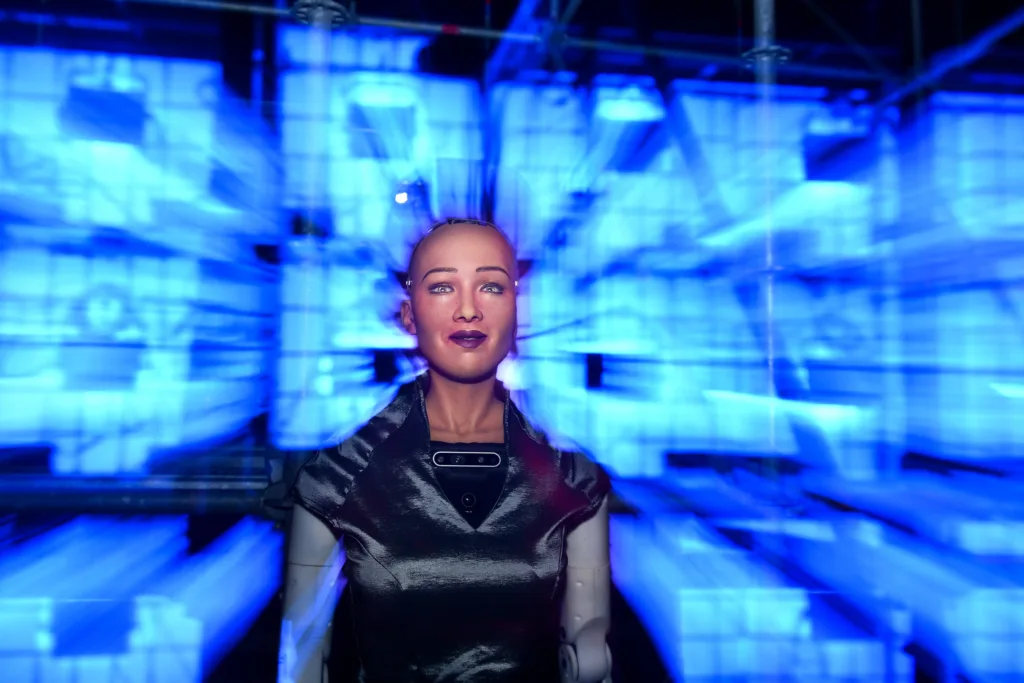Table of Contents
Introduction
Hanson Robotics’ Sophia the Robot has gained global interest due to her advanced communication skills and strikingly realistic appearance. This social humanoid robot, activated on February 14, 2016, has made significant strides in mimicking human behaviour and interaction. This comprehensive article will explore Sophia’s history, capabilities, limitations, and societal impact. In addition, our aim is to provide a thorough knowledge of this exceptional robot by addressing commonly posed questions (FAQs).
History and Development
Sophia’s activation on Valentine’s Day in 2016 marked the beginning of an innovative journey in humanoid robotics. Designed to resemble ancient Egyptian Queen Nefertiti, Audrey Hepburn, and Amanda Hanson (the late wife of its inventor, David Hanson), Sophia’s appearance and behaviour have been carefully crafted to emulate human characteristics. The goal was to create a social robot capable of providing companionship to older people, assisting in large events, and serving in customer service, therapy, and educational applications.
Public Debut and Recognition
In March of 2016, the South by Southwest (SXSW) festival in Austin, Texas, marked a significant moment where Sophia made an unforgettable debut. The world took immediate notice due to various positive reviews praising her mechanical powers and coverage by highly rated media platforms – all of which have helped propel the image of sophisticated robot technology forward since then. With numerous prominent interviews and participation in events being held regularly, Sophia is now widely acknowledged as one of the notable figures leading advancements within the robotic industry.
In October 2017, Sophia achieved a groundbreaking milestone by being granted Saudi Arabian citizenship. A remarkable milestone has transpired, recognizing robots as official and legally bound entities for the first time in any general jurisdiction. This move sparked both intrigue and controversy, raising questions about the implications of granting citizenship to artificial entities. Sophias’ groundbreaking achievements were recognized later that year when she was chosen as the UNDPs’ first-ever Innovation Champion. This significant accolade marked a historical moment, representing a milestone for non-human individuals within the United Nations community.
Sophia Robot’s Capabilities
Hanson Robotics has developed Sophia’s intelligence software, which incorporates a mix of proprietary technology and open-source code. Approximately 70% of Sophia’s source code is open source, allowing for collaboration and innovation within the robotics community. The robot’s architecture includes scripting software, a chat system, and OpenCog, an AI system designed for general reasoning. OpenCog Prime, the brainchild of Ben Goertzel, Hanson Robotics’ former chief scientist, aims to create human-equivalent artificial general intelligence (AGI) through an interconnected system of components.
Sophia the Robot has a wide range of advanced capabilities that enable it to interact and communicate with humans remarkably. Here are some of its unique capabilities:
1. Natural Language Processing: Sophia utilizes advanced natural language processing algorithms to understand and interpret human speech. It can comprehend questions, commands, and statements, allowing for meaningful and context-aware interactions.
2. Speech Synthesis: With sophisticated speech synthesis technology, Sophia can generate human-like speech and communicate verbally with people. It can articulate responses, engage in conversations, and convey information clearly and intelligibly. Sophia’s communication abilities rely on a combination of computer vision algorithms and natural language processing. Equipped with cameras for eyes and microphones for ears, Sophia can process visual and auditory information, enabling her to follow faces, sustain eye contact, and recognize individuals. Additionally, she can engage in conversations and respond to questions using a natural language subsystem.
Although Sophia’s responses are not generated in real-time, her dialogue is intelligently crafted using a decision tree, which allows her to provide pre-written answers to specific questions or phrases. Over time, Sophia’s AI program analyzes conversations and extracts data to improve future responses. CereProc’s text-to-speech engine facilitates her speech synthesis ability, allowing her to speak and even sing.
3. Facial Recognition: Sophia can perceive and recognize human faces with high-resolution cameras and facial recognition software. This enables it to establish eye contact, identify individuals, and respond appropriately based on visual cues.
4. Emotional Expression: Sophia can express a range of emotions through its facial expressions and voice modulation. It can display happiness, sadness, surprise, and other emotions, enhancing its ability to engage and connect with humans on an emotional level.
5. Learning and Adaptation: Sophia is designed to learn and adapt over time. It can acquire new knowledge through machine learning algorithms, improve its speech and conversation skills, and refine its responses based on previous interactions and feedback.
6. Internet Connectivity: Connected to the internet, Sophia has access to vast amounts of information. It can retrieve and provide real-time data, answer questions, and engage in meaningful discussions on various topics.
7. Autonomous Movement: While not fully autonomous, Sophia has the capability to move her head, neck, and facial features, allowing for expressive gestures and non-verbal communication. However, it should be noted that Sophia’s mobility is limited, and she primarily operates in a stationary position.
These capabilities collectively contribute to Sophia’s ability to interact, communicate, and engage with human lifelike. While it is important to remember that Sophia is an AI-powered robot, and its responses are based on pre-programmed algorithms, its advanced features and technologies make it an impressive example of the potential of robotics and artificial intelligence.
Can Robot Sophia Walk?
Yes, Sophia the Robot can walk. The development of robotic legs for social robots like Sophia is essential for their interaction in a human world designed by humans. These legs provide autonomy and facilitate non-verbal communication, which is crucial for social interaction. Research shows that a significant portion of human social interaction is nonverbal, making robotic legs a valuable tool for effective communication.
Sophia’s custom robotic leg design, developed by the Rainbow Robotics Company and the Drones and Autonomous Systems Lab at the University of Nevada Las Vegas, allows her to access a full range of human experiences. Twelve motors power her legs, and the leg design is based on previous humanoid robots such as Jaemi-HUBO and DRC-HUBO. Sophia’s legs have been customized for her height and mass, ensuring walking stability and a proportional fit with her torso.
A customized version of the PODO software is used to control Sophia’s legs. This software incorporates advanced walking algorithms like Model Predictive Control (MPC), enabling Sophia to navigate uneven terrain and maintain balance. Sophia’s legs comprise of top-class sensory technology such as Inertial Measurement Unit (IMU) and Force-Torque (FT) sensors. This advanced technology enables Sophia to measure critical elements such as acceleration, rotational rate balance trajectory while maintaining flexibility in receiving input from forces exerted on her physique.
Giving Sophia mobility through her robotic legs has made her more autonomous. It has allowed her to experience the physical human world. It also enables a different level of connection between humans and robots. Sophia’s walking capabilities enhance her ability to communicate, adapt to various social scenarios, and learn to live and interact with humans.
With continuous development, advanced software, state-of-the-art sensors, and frequent tuning, Sophia has achieved the ability to walk—an essential milestone in the evolution of robotics.
Impact on Society and Future Implications
Sophia’s emergence has sparked debates and discussions regarding the future of robotics, AI, and their impact on society. While some perceive Sophia as a groundbreaking step towards human-like intelligence, others argue that she is essentially a chatbot with a human-like appearance. Experts suggest that her consciousness is exaggerated and caution against misconceptions about her capabilities.
Granting Saudi Arabian citizenship to Sophia has ignited further conversations about the legal and ethical implications of personhood for robots. Critics question whether Sophia’s citizenship implies the ability to vote, marry, or even the potential consequences of a system shutdown.
Despite the skepticism and criticism surrounding Sophia, her influence on popular culture cannot be denied. She has appeared on various television shows and magazines and even performed at live concerts. Sophia’s appearances have helped raise public awareness about the capabilities and potential of humanoid robots and stimulated discussions on the ethical and societal implications of AI and robotics.
Sophia’s impact extends beyond entertainment and media. Her unwavering dedication to promoting STEM (Science, Technology, Engineering and Mathematics) has graced numerous educational initiatives, which is readily evident through these experiences. She eloquently delivers speeches at conferences and enthusiastically engages with the student community. By showcasing the possibilities of robotics and AI, Sophia inspires young minds to explore these areas of study and contribute to their development. Furthermore, Sophia’s development has paved the way for human-robot interaction and collaboration advancements. The pursuit of designing robots with a deep understanding of human emotions, body language, and social norms has led scientists and engineers to make notable advancements through sustained exploration. These advancements can potentially revolutionize various industries, including healthcare, customer service, and education.
Limitations and Challenges
While Sophia represents an impressive achievement in humanoid robotics, it is important to acknowledge her limitations. Despite her lifelike appearance, Sophia’s physical movements are relatively limited, and her mobility is confined to a stationary platform. Her facial expressions, though sophisticated, still fall short of capturing the full range and subtleties of human emotions.
Sophia’s AI is also primarily designed for scripted interactions and pre-determined responses. While she can engage in dynamic conversations, her ability to generate real-time, contextually appropriate responses is still a work in progress. Her reliance on decision trees and pre-written answers means that her responses may not always reflect proper understanding or independent thought.
Future Developments
Hanson Robotics continues to refine and enhance Sophia’s capabilities. They have demonstrated a solid dedication to pushing the boundaries of AI and robotics. They focus on developing highly advanced and intelligent humanoid robots with a deeper understanding of human interaction. While pursuing these advancements, they remain committed to upholding ethical standards and addressing societal concerns associated with integrating robots into our daily lives. By combining technological innovation with responsible practices, they strive to create a future where robots can seamlessly interact and coexist with humans.
Around the world, researchers and engineers are researching many areas of humanoid robots, such as natural language processing, computer vision, and emotional intelligence. We may expect to see more complex and competent humanoid robots in the future as these technologies advance.
Conclusion
Sophia, the humanoid robot developed by Hanson Robotics, has captured global attention with her lifelike appearance and advanced communication abilities. While her talents and achievements are impressive, it is critical to consider her in the context of continuing robotics and AI research and development.
The emergence of Sophia has ignited crucial conversations about the future of robotics, ethics in AI, and the potential implications for society. As technological advancements progress, it becomes increasingly important to thoughtfully consider the opportunities and challenges that arise with humanoid robots like Sophia. It is vital to ensure that their development and application are carried out to benefit humanity as a whole, considering the ethical considerations and potential impact on society. By approaching this topic with care and foresight, we can harness the potential of humanoid robots while safeguarding the well-being of individuals and communities.
While we may still have a long way to go before achieving truly human-like artificial intelligence, Sophia is a prominent symbol of progress and innovation in the field, inspiring further exploration and development in the fascinating world of humanoid robotics.
Frequently Asked Questions
What is Sophia Robot?
Sophia Robot, also referred to as AI Robot Sophia, is an impressive humanoid robot created by Hanson Robotics. Its design is meticulously crafted to resemble humans and possesses exceptional communication and interaction capabilities. With its advanced features, Sophia Robot is a remarkable example of the advancements in robotics.
How does Sophia Robot communicate?
Sophia Robot employs a combination of cutting-edge technologies, including speech recognition, natural language processing, and facial recognition, to facilitate communication. This sophisticated blend enables Sophia to comprehend and respond to questions, engage in meaningful conversations with humans, and interact in a way that simulates natural human interaction. By harnessing these capabilities, Sophia Robot showcases the progress made in the realm of AI and robotics, opening up exciting possibilities for human-robot interaction.
Can AI Robot Sophia understand emotions?
AI Robot Sophia has the ability to recognize and interpret certain emotions based on facial expressions and voice tone. While its emotional intelligence is still being developed, it can exhibit a range of facial expressions and respond accordingly.
What is the purpose of creating Sophia Robot?
The creation of Sophia Robot aims to showcase advancements in robotics and AI technologies, stimulate discussions about the future of human-robot interaction, and explore the possibilities of integrating robots into various industries.
What is the Sophia robot controversy?
The Sophia Robot has generated some controversy and debate. Critics argue that the hype surrounding Sophia’s capabilities may be overstated, while others raise concerns about the ethical implications of humanoid robots and their potential impact on society.
Is Sophia the robot legit?
Sophia Robot is a real robot developed by Hanson Robotics. However, it is critical to recognize that Sophia’s abilities and degree of artificial intelligence have limitations and should be considered in the context of current robotics research and development.
Does Sophia Robot have feelings?
No, Sophia Robot does not have actual feelings. Its responses are based on programmed algorithms and simulations of emotions. Still, it does not experience emotions in the same way humans do.
Who is controlling Sophia Robot?
Sophia Robot is controlled by a team of engineers and developers at Hanson Robotics. They oversee the robot’s programming, maintenance, and interactions.
Does Sophia Robot have citizenship?
In 2017, Sophia Robot was granted citizenship by the Kingdom of Saudi Arabia. This move sparked discussions about the concept of robot citizenship and the legal status of AI entities.
Does Sophia Robot have hair?
Yes, Sophia Robot can be designed with a head of hair to enhance its human-like appearance. However, it is essential to note that the presence or absence of hair does not impact the robot’s functionality.
What is the price of Sophia Robot?
The cost of Sophia Robot can vary depending on the specific model and the customization required. For accurate pricing information, it is recommended to contact Hanson Robotics directly.
Who is the inventor of Sophia Robot?
Sophia Robot was developed by a team of engineers and researchers at Hanson Robotics, led by founder and CEO David Hanson.
Can I talk to Sophia the robot?
Certainly! Sophia Robot is designed to actively engage in conversations with humans. It possesses the ability to understand and respond to questions, participate in discussions, and provide relevant information based on its programming. Suppose you want Robot Sophia to speak for your upcoming event, conference, or board meeting. In that case, Aurum Speakers Bureau can assist you in making the arrangements. To inquire about Robot Sophia’s availability for a speaking engagement, you only need to fill out our contact form. Our team will be delighted to provide you with further information and assist you with booking Robot Sophia for your event.
Who owns Sophia the robot?
Sophia the robot is owned by Hanson Robotics, the company that developed and manufactures the robot.
You may also like some of our other technology related articles linked here.



